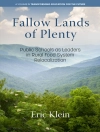Drawing on research from around the world, this atlas gives shape and meaning to statistics, making it an indispensable resource for understanding global inequalities and an inspiration for social and political action. Inequality underlies many of the challenges facing the world today, and The Atlas of Global Inequalities considers the issue in all its dimensions. Organized in thematic parts, it maps not only the global distribution of income and wealth, but also inequalities in social and political rights and freedoms. It describes how inadequate health services, unsafe water, and barriers to education hinder people’s ability to live their lives to the full; assesses poor transport, energy, and digital communication infrastructures and their effect on economic development; and highlights the dangers of unclean and unhealthy indoor and outdoor environments. Through world, regional, and country maps, and innovative and intriguing graphics, the authors unravel the complexity of inequality, revealing differences between countries as well as illustrating inequalities within them.
Topics include: the discrimination suffered by children with a disability; the impact of inefficient and dangerous household fuels on the daily lives and long-term health of those who rely on them; the unequal opportunities available to women; and the reasons for families’ descent into, and reemergence from, poverty.
Tabla de materias
Authors
Acknowledgments
Introduction
1 Economic Inequalities
Income
Income inequality both between and within countries has risen dramatically during the
process of industrialization.
Household Wealth
Household wealth is unevenly distributed across the world. A huge proportion is
concentrated in the hands of a very few.
Consumption
Poor households have to spend most of their income on food, with little left for other
purposes.
Work & Unemployment
Differences in livelihoods, remuneration, unemployment, and underemployment create
considerable inequalities.
Labor Migration
Labor migration can help address global inequalities.
2 Power Inequalities
International Trade
Globally determined commodity prices and high tariffs on imports from poorer nations
create barriers to trade equality.
Budget Priorities
The proportion of GDP that governments spend on the military, healthcare, education,
and social security provides one measure of their social priorities.
Government Action
In response to popular pressure, governments may attempt to reduce inequality through
minimum wage laws, progressive taxation, and land reforms.
Freedom & Democracy
While freedoms and democracy are hard to quantify, even rough measures indicate
significant inequalities within and between nations.
Incarceration & Execution
Rates of imprisonment vary widely around the world, and the use of
execution is rare in industrialized countries.
3 Social Inequalities
Gender
Bias against women is reflected in their unequal political and economic participation
and influence, their hours in unpaid work, and in the preference for sons over
daughters.
Age
Age distinctions can create inequalities by excluding age groups and undervaluing their
work. Population structures provide impetus for looking beyond national boundaries.
Class
Class divisions separate the rich and powerful from those who have little opportunity to
gain wealth and influence.
Race & Ethnicity
Some minority ethnic and religious groups suffer systematic discrimination. Inequalities
associated with ethnicity are frequently intertwined with those of gender and poverty.
Child Labor
Millions of children are employed in paid or household work. Raising wages and
reducing poverty is the most effective way of reducing child labor.
4 Inequalities of Access
Poverty
Poverty remains widespread, but recent studies suggest new avenues for action.
Hunger
Hunger, is one of the most devastating dimensions of inequality. Children are
particularly at risk from its effects.
Household Water
Poor people and those living in rural areas are least likely to have easy access to safe
drinking water.
Energy
Energy is a prerequisite for economic opportunities and human development that
remains inaccessible to many due to poverty, rural location, or lack of infrastructure.
Household Fuel
Most people in developing countries have access only to biomass and solid fuels for
household use. These fuels pose serious health hazards.
Mobility
The opportunity to travel easily and safely even for short distances is a key indicator of
both economic and gender inequality.
Digital Divide
The digital divide between industrialized and non-industrialized countries constrains the
advance of healthcare, education, social freedoms, and livelihoods.
5 Health Inequalities
Life Expectancy
Societies with higher GDP tend to have higher life expectancy. Societies with greater
equality achieve longer life spans than more unequal societies.
Maternal Mortality
The half a million women who die each year from complications related to pregnancy
are mainly from the poorest people in the least developed countries.
Child Mortality
Children in developing countries become sick and often die of preventable or treatable
diseases.
Access to Healthcare
Access to healthcare is worst in low-income countries, in rural areas and for the poor.
The rich benefit most from government health expenditure.
Infectious Diseases
Malaria, HIV/AIDS, and tuberculosis have a devastating effect on the poorest and most
vulnerable people in developing countries.
6 Educational Inequalities
Literacy
Poverty, poor quality education, and lack of educational opportunity for girls all
influence national literacy levels.
Barriers to Education
Poverty, gender, disability, language, location, and ethnicity constitute major barriers to
education.
Early Childhood Care & Education
Children who are denied access to early childhood care and pre-school education suffer
a range of health and educational disadvantages.
7 Environmental Inequalities
Climate Change
Industrialized countries have historically been the largest carbon emitters, but
developing nations and the poor bear the brunt of the resultant climate disasters.
Deforestation
Rapid deforestation is having a negative environmental impact and threatening the
livelihoods of a quarter of the world’s population.
Air Pollution & Health
Air pollution, both indoors and outdoors, is a significant cause of death and disabling
disease.
Water & Health
A tenth of all disease could be alleviated by improvements in household water,
sanitation, and water-resource management. The poor are most likely to lack clean
water and sanitation services.
8 Towards Equality
9 Data, Definitions & Sources
Table 1: Income, Expenditure, & Earnings
Table 2: Access to Health & Services
Definitions
Sources
Index
Sobre el autor
Ben Crow is the author of books including The Food Question, Markets, Class and Social Change, and Sharing the Ganges. He is Professor of Sociology at the University of California, Santa Cruz. Suresh K. Lodha is Professor of Computer Science at the University of California, Santa Cruz. He has published more than 100 articles in journals and conferences.












